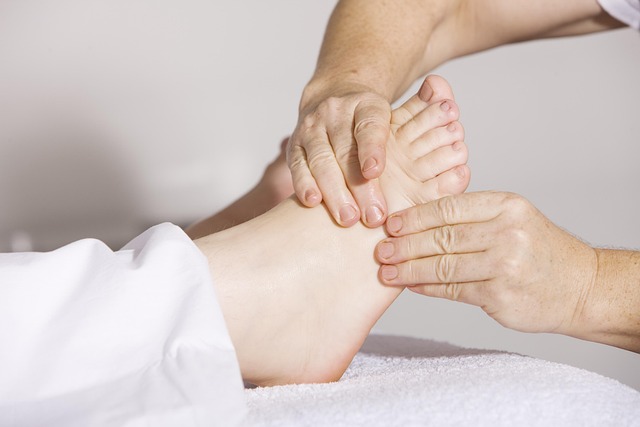Cold therapy, including ice packs, cold water immersion, and methods like the RICE protocol, is a powerful tool for accelerating sports injury recovery. By reducing inflammation, constricting blood vessels, and slowing metabolic processes, it aids in healing, repairs tissues, and prevents further damage, especially for muscle strains, sprains, and post-training soreness. Modern advancements like cryotherapy and cold water immersion build on traditional ice therapy, offering faster recovery times and improved athletic performance. Case studies demonstrate their effectiveness in treating chronic muscle soreness and injuries, providing concrete evidence of cold therapy's benefits for athletes seeking quicker return to competition.
Speed up your sports injury recovery with the power of cold therapy. This ancient practice, increasingly backed by modern science, offers a game-changing approach to managing pain and accelerating healing. From the classic RICE method to advanced cryotherapy, this article explores how cold therapy can unlock faster recovery for muscle injuries, reducing inflammation and numbing pain effectively. Discover real-world success stories from athletes who have harnessed the benefits of ice therapy for injury recovery, including cold water immersion and targeted cold compresses.
Understanding Cold Therapy: Unlocking the Power of Ice for Sports Injuries
Cold therapy, also known as ice therapy or cryotherapy, has long been recognized as a powerful tool in accelerating recovery from sports injuries. By applying cold compresses, such as ice packs or cold water immersion, athletes can unlock several benefits that aid in injury healing. The primary mechanism behind cold therapy involves reducing inflammation and minimizing pain by constricting blood vessels and slowing down metabolic processes in the affected area.
For athletes suffering from muscle strains, sprains, or post-training soreness, the RICE method (Rest, Ice, Compression, Elevation) is a widely recommended approach. Icing sports injuries can significantly alleviate discomfort, promote faster tissue repair, and reduce the risk of further damage. The benefits extend beyond immediate pain relief; regular cold therapy sessions can enhance overall recovery time, allowing athletes to return to their active routines sooner. This method is particularly effective for both acute injuries and chronic conditions that result from repetitive micro-traumas in high-intensity sports.
The Science Behind Cold Therapy: How It Accelerates Recovery
Cold therapy has long been a go-to treatment for athletes suffering from sports injuries. The science behind its effectiveness lies in several key mechanisms. When an injury occurs, applying cold (often through ice packs or cold water immersion) helps to constrict blood vessels, reducing blood flow to the affected area. This diminishes inflammation and minimizes swelling, two primary contributors to pain and discomfort during the recovery process.
Additionally, cold therapy numbs nerve endings, providing temporary relief from pain. It also helps relax muscles, which can aid in reducing spasms and stiffness. The RICE method (Rest, Ice, Compression, Elevation), a widely accepted protocol for immediate care of sports injuries, emphasizes the role of ice therapy in accelerating recovery. Studies have shown that regular use of cold compresses can significantly shorten recovery time for muscle injuries, making cryotherapy a valuable tool for athletes looking to get back in the game faster and safely.
Implementing Cold Therapy Techniques: From RICE to Advanced Cryotherapy
Implementing Cold Therapy Techniques: From RICE to Advanced Cryotherapy
For decades, the RICE (Rest, Ice, Compression, Elevation) method has been a cornerstone in managing sports injuries. This approach involves resting the affected area, applying ice packs to reduce swelling and pain, compressing the injury to minimize inflammation, and elevating it above heart level. While effective, modern advancements have introduced more sophisticated cold therapy techniques, such as cryotherapy and cold water immersion, that offer enhanced benefits for athletes seeking quicker recovery times.
Cryotherapy involves exposing the injured area to extremely cold temperatures for short periods, stimulating blood flow to flush out metabolic waste products and reducing inflammation. Cold water immersion, on the other hand, involves submerging the affected limb in cold water, which has been shown to significantly reduce muscle soreness and speed up recovery times. These advanced methods build upon the foundational principles of ice therapy while incorporating cutting-edge technology to deliver more precise and efficient results for athletes recovering from sports injuries.
Real-World Success Stories: Athletes Share Their Experiences with Cold Therapy
Many professional athletes have turned to cold therapy as a game-changer in their injury recovery processes. The stories they share highlight the real-world benefits of this approach. For instance, several runners who suffered from chronic muscle soreness and injuries found significant relief through regular ice baths and cold water immersions. They reported quicker healing times, reduced inflammation, and improved flexibility after incorporating cryotherapy into their routines.
One prominent case involves a professional basketball player who experienced severe knee pain due to intense training. After adopting the RICE method (Rest, Ice, Compression, Elevation), along with localized cold compresses on the affected area, his recovery accelerated dramatically. He shared that the initial discomfort from ice therapy dissipated within days, and he was able to resume full-contact practices much sooner than expected. These success stories not only inspire but also provide concrete evidence of cold therapy’s effectiveness in expediting sports injury recovery.
Cold therapy has emerged as a powerful ally in the realm of sports medicine, offering athletes a fast and effective way to recover from injuries. By harnessing the science-backed benefits of ice and cryotherapy, from the traditional RICE method to advanced techniques, athletes can experience accelerated recovery, reduced pain, and improved performance. Real-world success stories shared by athletes themselves underscore the transformative potential of cold therapy for sports injuries, making it an indispensable tool in any active individual’s recovery arsenal.
